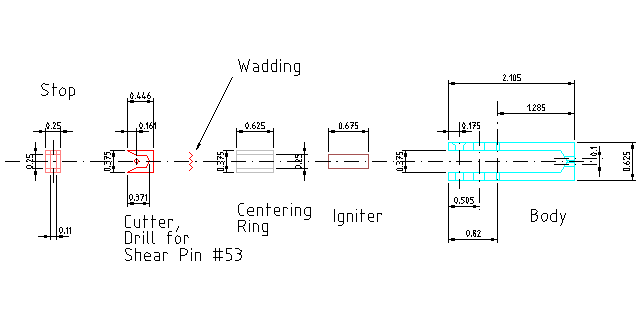The line cutters are electrically actuated. They cut the drogue parachute line at low altitude to release the main parachute.

A DXF format drawing of the v2 cutters is available here. (The drawing is also available in pdf format.)
This page documents the old-style v2 cutters we used on LV2a & LV2b. We're currently in the process of redesigning then to enhance their reliability.
The v2 cutters use an oil hardening steel piston actuator (labeled 'Cutter' in the drawings) which is explosively propelled inside an aluminum body tube. The piston has a circular cutting edge formed by drilling a 3/8" steel rod with a combination center drill, cutting to length, heat treating the blank, and then sharpening the edge with a small grinder while spinning the whole piston in a drill chuck or similar holder.

We also have movies of the v2 cutter operating on a slack line, and a loaded line.
The v2 line cutters have a perfect operating success record. This includes the very first test up to the present. The cutters are also light weight and reasonably easy to make.
Although the v2 cutters are high performance devices, there are nonetheless a couple things we'd like to improve upon. They are somewhat difficult to assemble, and they have a serious flaw in their cutting action.
Despite cutting the line successfully every time, the v2 cutters have a tendency to jam threads from the line's outer abrasion cover between the piston cutter and the body wall. This has never prevented the line from releasing, but at worst it has required about 5 lbs of pull force to remove the cut line from the cutter body.
The line we cut is 4 mm climbing accessory line which we get from REI inc., a local sporting goods retailer. The 4 mm line is a good choice in several ways. It's available locally at a moderate price, it has a believable load rating, and it's a robust line resistant to abrasion, kinking, etc.
I should look this up, but if i recall correctly, the price of 4 mm accessory line is about 25 cents per foot, and it has an 800 lbs load rating. Accessory line is a low stretch line with a core of relatively straight fibers and a braided cover of very fine threads which protect the core from abrasion and other damage.
It is the very fine threads in the outer cover that have proved hard to cut. Most of our tests are purposely done on slack lines, which exacerbates the difficulty in getting a cleanly cut line. By its nature, the piston actuator used in the v2 cutter requires fairly close tolerance to get a good gas seal, but some gap between the piston and the body must exist to allow movement of the piston. This gap is where the fine outer threads can be jammed during cutter operation.
The very first test we did had the worst jam we ever got. Originally we had the stop (refer to the drawing) placed well behind the holes through which the 4 mm line passed. The result was that outer fibers could be carried a considerable distance past the holes by the sliding action of the cutter, and thus become well jammed in place.
Our solution was to extend the stop so that it ended only a few ten-thousandths of an inch behind the hole. As a result, the line could not jam, and even if a few fibers remained un-cut they would be in tension at the point where the cutter had just acted. After this change we observed that the fibers always broke with less than one pound of applied force. We often counted the number of un-cut fibers after a firing. Typical numbers were 4-8, with highs about 20. These are very fine fibers, finer than a human hair.
One cutter piston in particular always left fewer than 4 fibers un-cut. Most often this cutter would leave no fibers un-cut. We used this cutter as our primary cutter on all actual flights, but we were not able by eye to discern what made this cutter better than the others.
We think we know why the cutting action of the v2 cutters is subject to jamming. First the tight space between the piston and body wall is inherently a jammable location. Second, the dual-cutting action of the circular cutter prevents consistent generation of a self-wiping force, such as is afforded by the outer bevel of better-style hand scissors. In the scissors, this wiping force presses the blades together as they cut, preventing thread jamming between the blades.
I think we have two reasonable solutions to our problem. We have come up with a piston actuator with a straight rather than round cutting edge. Looking around so far it looks like most other designs use a similar mechanism.
With a straight cutting edge we seem to loose the benefit of confining the fibers closely in the body tube holes as the cutter shears them. Instead we will provide a flat anvil at the end of the tube against which the piston cutting edge will act.
The lack of confinement of the line will allow the line to flatten out against the anvil as it is cut. I predict that this will lead again to un-cut fibers. To counter that tendency, we can use a close fitting plastic ring around the line as it passes through the cutter body. This should confine the line sufficiently to guarantee that all the fibers are cut.
The plastic material and shape must be chosen carefully so that the line is not jammed by deformation of the plastic, and so that the cutter has room to move complete its full stroke without excessive interference.
Alternatively, the v2 design might be re-used with the addition of the plastic confinement ring.
Attachments: